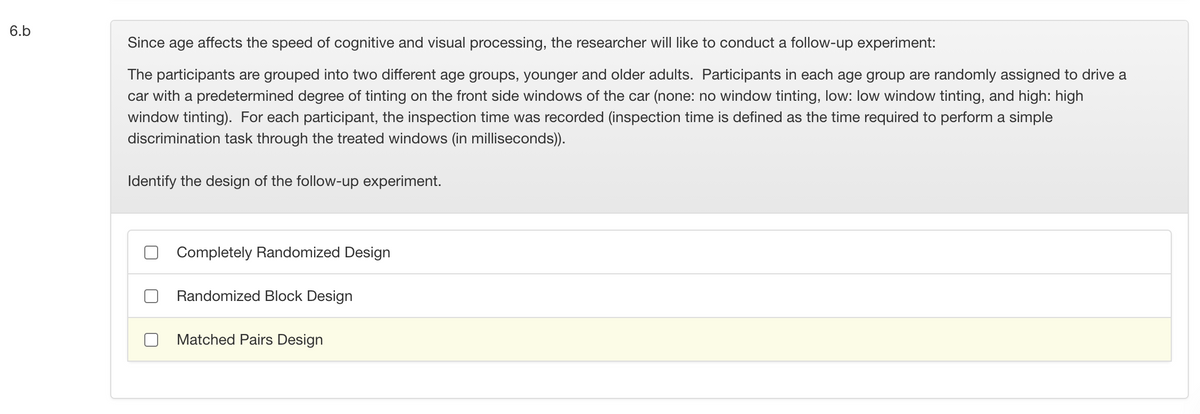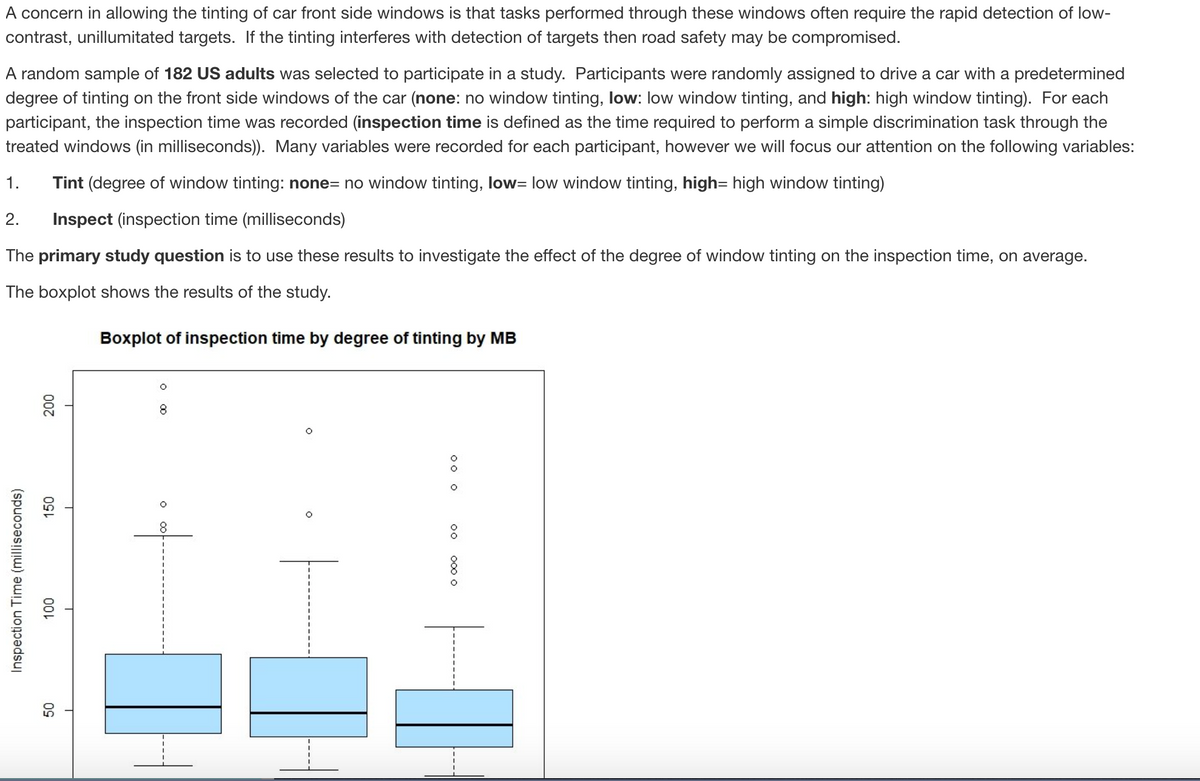Since age affects the speed of cognitive and visual processing, the researcher will like to conduct a follow-up experiment: The participants are grouped into two different age groups, younger and older adults. Participants in each age group are randomly assigned to drive a car with a predetermined degree of tinting on the front side windows of the car (none: no window tinting, low: low window tinting, and high: high window tinting). For each participant, the inspection time was recorded (inspection time is defined as the time required to perform a simple discrimination task through the treated windows (in milliseconds)). Identify the design of the follow-up experiment. Completely Randomized Design Randomized Block Design Matched Pairs Design
Since age affects the speed of cognitive and visual processing, the researcher will like to conduct a follow-up experiment: The participants are grouped into two different age groups, younger and older adults. Participants in each age group are randomly assigned to drive a car with a predetermined degree of tinting on the front side windows of the car (none: no window tinting, low: low window tinting, and high: high window tinting). For each participant, the inspection time was recorded (inspection time is defined as the time required to perform a simple discrimination task through the treated windows (in milliseconds)). Identify the design of the follow-up experiment. Completely Randomized Design Randomized Block Design Matched Pairs Design
Holt Mcdougal Larson Pre-algebra: Student Edition 2012
1st Edition
ISBN:9780547587776
Author:HOLT MCDOUGAL
Publisher:HOLT MCDOUGAL
Chapter11: Data Analysis And Probability
Section: Chapter Questions
Problem 8CR
Related questions
Question
Please read the following prompt, analyze the following graph, and complete question 6.b

Transcribed Image Text:6.b
Since age affects the speed of cognitive and visual processing, the researcher will like to conduct a follow-up experiment:
The participants are grouped into two different age groups, younger and older adults. Participants in each age group are randomly assigned to drive a
car with a predetermined degree of tinting on the front side windows of the car (none: no window tinting, low: low window tinting, and high: high
window tinting). For each participant, the inspection time was recorded (inspection time is defined as the time required to perform a simple
discrimination task through the treated windows (in milliseconds)).
Identify the design of the follow-up experiment.
Completely Randomized Design
Randomized Block Design
Matched Pairs Design

Transcribed Image Text:A concern in allowing the tinting of car front side windows is that tasks performed through these windows often require the rapid detection of low-
contrast, unillumitated targets. If the tinting interferes with detection of targets then road safety may be compromised.
A random sample of 182 US adults was selected to participate in a study. Participants were randomly assigned to drive a car with a predetermined
degree of tinting on the front side windows of the car (none: no window tinting, low: low window tinting, and high: high window tinting). For each
participant, the inspection time was recorded (inspection time is defined as the time required to perform a simple discrimination task through the
treated windows (in milliseconds)). Many variables were recorded for each participant, however we will focus our attention on the following variables:
1.
Tint (degree of window tinting: none= no window tinting, low= low window tinting, high= high window tinting)
2.
Inspect (inspection time (milliseconds)
The primary study question is to use these results to investigate the effect of the degree of window tinting on the inspection time, on average.
The boxplot shows the results of the study.
Boxplot of inspection time by degree of tinting by MB
8
ㅇ
8.
ㅇㅇ ㅇ
0o
000 o
007
Inspection Time (milliseconds)
Expert Solution
This question has been solved!
Explore an expertly crafted, step-by-step solution for a thorough understanding of key concepts.
This is a popular solution!
Trending now
This is a popular solution!
Step by step
Solved in 2 steps

Knowledge Booster
Learn more about
Need a deep-dive on the concept behind this application? Look no further. Learn more about this topic, statistics and related others by exploring similar questions and additional content below.Recommended textbooks for you

Holt Mcdougal Larson Pre-algebra: Student Edition…
Algebra
ISBN:
9780547587776
Author:
HOLT MCDOUGAL
Publisher:
HOLT MCDOUGAL

Holt Mcdougal Larson Pre-algebra: Student Edition…
Algebra
ISBN:
9780547587776
Author:
HOLT MCDOUGAL
Publisher:
HOLT MCDOUGAL